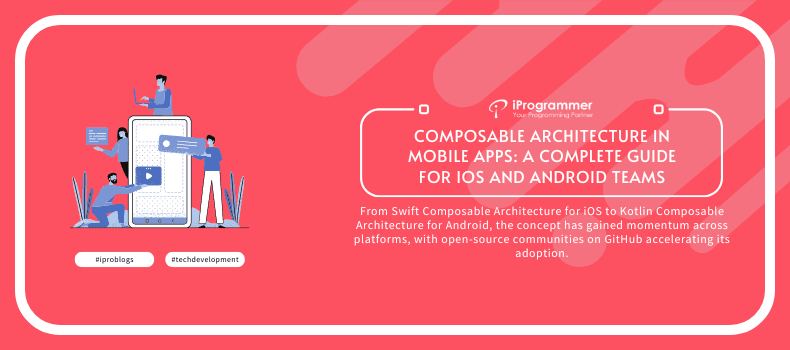Composable Architecture in Mobile Apps: A Complete Guide for iOS and Android Teams
- What is Composable Architecture?
- Why Mobile Apps Need Composable Architecture Now
- Key Principles of Composable Architecture
- Composable Architecture in iOS Development
- Composable Architecture in Android Development
- Frameworks, Tools, and Community Resources
- Real-World Composable Architecture Examples
- Common Pitfalls and How to Avoid Them
- The Future of Composable Architecture in Mobile Apps
- Takeaway
- About iProgrammer
The way that mobile applications are constructed these days is considerably different from a decade ago. Users today no longer only anticipate natural but also trendy, personalized, and consistent user experiences across devices. These expectations call for diverse sets of features, multiple form factors, diminishing cycle times, and the requirement for frictionless scalability.
Traditional development patterns — static, monolithic codebases—are frequently not able to keep up. Introducing a new feature can be like doing surgery on a runaway train: risky, time-consuming, and likely to have side effects. Composable Architecture swoops in as the game-changer, offering the chance to build mobile applications that are flexible, testable, and modular from day one.
Rather than viewing the application as a single, unbreakable entity, composable thinking breaks it down into separate pieces. Whether the feature is a login screen, cart, or notifications system, each can be written, tested, and released separately from the other pieces of the app. This allows teams to respond more rapidly to what users need, test safely, and maintain a more disciplined codebase in the long term.
From Swift Composable Architecture for iOS to Kotlin Composable Architecture for Android, the concept has gained momentum across platforms, with open-source communities on GitHub accelerating its adoption. In the sections ahead, we’ll unpack how it works, why it matters now more than ever, and how mobile teams can leverage it to build future-ready apps that are both resilient and innovative.
What is Composable Architecture?
Composable Architecture is a design pattern that structures an application into separate, independent, replaceable pieces—generically called “features” or “modules.” As opposed to monolithic designs, where changes have unpredictable effects on the codebase, composable systems encapsulate responsibility so that each piece is predictable, testable, and replaceable.
In mobile app development, this approach has two defining strengths:
- Feature Independence – Every feature (say, authentication, payment, or user profile) is implemented as a separate module, having its own state, actions, and side effects.
- Clear Data Flow – Through enforcing unidirectional data flow, state management becomes simpler to reason about, debug, and optimize.
A key concept here is Composable Architecture Navigation. Rather than hard-coded screen changes hidden deep within the app logic, navigation is treated as a composable, modular component. Adding a new route or reorganizing flows no longer means refactoring the whole navigation stack—a total game-changer for apps with deeply complicated user flows.
For iOS Composable Architecture teams, this usually involves using the Swift Composable Architecture framework, where each feature is independent and interacts through well-defined interfaces. Android Composable Architecture—often accompanied by Kotlin and Jetpack Compose—is also the same, allowing dynamic UI and state management without tightly coupling features together.
The concept is not limited to proprietary implementations; the developer community has been instrumental in evolving it. On GitHub Composable Architecture repositories, you’ll find robust open-source frameworks and ready-to-use patterns contributed by engineers worldwide. These resources offer tested approaches, sample projects, and utilities that accelerate implementation while ensuring code remains clean and maintainable.
Why Mobile Apps Need Composable Architecture Now

The mobile app environment has been transformed significantly during the past few years. Customers expect fast feature delivery, smooth performance, and customized experiences—sometimes all simultaneously across iOS, Android, and web. Meanwhile, development teams are under increasing pressure from:
- Shorter release cycles driven by competitive markets
- Growing sets of features that need to link to third-party services
- Changing UI frameworks such as SwiftUI and Jetpack Compose
- Cross-platform consistency while taking advantage of platform-specific features
Traditional patterns like MVC or MVVM tend to falter under such requirements. Their coupled nature implies that a small change in one feature propagates throughout the entire application, amplifying risk and hindering delivery.
Composable Architecture solves this by decoupling features structurally, allowing for independent development and deployment. For companies with both iOS Composable Architecture and Android Composable Architecture teams to manage, this equates to concurrent forward motion without dependency roadblocks—regardless of whether they are developing for a financial platform, an on-demand delivery platform, or an enterprise productivity suite.
| Aspect | Traditional Architecture | Composable Architecture |
| Feature Development | Sequential, interdependent | Parallel, independent |
| State Management | Scattered across layers | Centralized & predictable |
| Testing | Often requires full app load | Unit-level & feature-specific |
| Navigation Changes | High refactoring risk | Modular & easily adjustable |
| Scalability | Difficult to maintain | Built for growth |
| Team Collaboration | Tightly coupled workflows | Clear boundaries between teams |
Key Principles of Composable Architecture
1. Modularity
Composability is all about breaking down the app into tiny, independent components—each with their own state, actions, and side effects. With modularity in place, teams can work on different sections of the app in parallel without stepping over each other’s code.2. Centralized State Management
Rather than spreading state to several views or controllers, the architecture stores state in a single, stable source of truth. This gets rid of bugs caused by inconsistent state and makes it easier to sync UI with business logic.3. Unidirectional Data Flow
Data propagates only in one direction: user actions cause state changes, which cause the UI updates. This makes application behaviour deterministic and greatly simplifies debugging.4. Testability
By separating out features and their dependencies, it’s now possible to run individual unit tests without loading the entire app into memory. That speeds up QA cycles and accelerates regression testing.5. Reusability & Replaceability
Modules thus made can be used across projects or swapped when requirements change—without having to rearchitect the remainder of the app.
struct CounterState { var count: Int = 0 }
enum CounterAction { case increment, decrement }
struct CounterEnvironment {}
let counterReducer = Reducer<CounterState, CounterAction, CounterEnvironment> { state, action, _ in
switch action {
case .increment: state.count += 1
case .decrement: state.count -= 1
}
return .none
} Composable Architecture in iOS Development

For iOS developers, Swift Composable Architecture or SCA is now one of the most important frameworks to use iOS Composable Architecture ideas in production-level apps. Developed by Point-Free, it introduces structure, predictability, and clarity to developing apps and blends smoothly with SwiftUI.
At its core, SCA organizes applications into three core building blocks:
- State – The single source of truth for each feature.
- Actions – Events that change the state.
- Reducers – Pure functions that specify how state transitions because of actions.
This disciplined form guarantees that even sophisticated iOS apps are still simple to use, debug, and extend.
Navigation in iOS Composable Architecture
One of the most compelling advantages of SCA is its approach to navigation. Instead of embedding navigation logic deep in views or controllers, it’s modelled as part of the state. This allows the navigation flow to be tested like any other part of the app and modified without breaking unrelated features. For instance, adding a new checkout screen in an eCommerce app becomes as simple as adding a new case in the navigation state and connecting it to a reducer—no risky view controller rewiring required.
Integration with SwiftUI
Since SwiftUI accommodates declarative UI and state-driven updates, it is compatible with Swift Composable Architecture. Views are lean, reactive layers that render themselves out of state, with reducers doing the heavy lifting of business logic. This decomposition lowers the cognitive load for developers and UI experimentation becomes safer.
Real-World Use Case
Consider a financial services app that needs to integrate account summaries, transaction history, budgeting tools, and secure messaging. Using iOS Composable Architecture, each of these modules can be developed in parallel by separate teams. The account summary functionality can be tested and released standalone without holding out for the completion of the messaging module—minimizing time-to-market significantly.
In addition, since all modules follow the same data flow pattern in one direction and reducer architecture, integrating new developers takes less time—they will only have to master the pattern once and be able to work anywhere in the application.
Composable Architecture in Android Development

While the iOS space has adopted frameworks such as Swift Composable Architecture, the world of Android has undergone a parallel evolution via Kotlin Composable Architecture–fuelled by the functionality of Jetpack Compose. Collectively, they provide Android teams with the means to build modular, reactive, and sustainable apps that can easily scale.
Why Jetpack Compose Complements Android Composable Architecture
Jetpack Compose’s declarative UI model allows developers to define UI as functions—making it inherently modular. When combined with Android Composable Architecture principles, each UI component aligns with a dedicated state container and business logic layer. This ensures that UI behaviour is predictable and changes are easy to track.
Instead of fragment-heavy, XML-based structures, developers can structure features as self-contained composable units—mirroring the modularity seen in advanced iOS architectures.
State Management and Data Flow
State in Kotlin Composable Architecture is generally handled through ViewModels and immutable state objects and updated by using unidirectional flows (e.g., Kotlin Flow or LiveData). The UI is observing these states and re-renders automatically when values are changed. This not only reduces boilerplate but also minimizes bugs caused by inconsistent UI states.
A typical setup involves:
- State – Immutable data class representing the UI state.
- Events/Actions – User or system triggers that request state changes.
- Reducers/Handlers – Pure functions or ViewModel logic that update state.
This structure allows developers to reason about each feature in isolation, making parallel development straightforward.
Navigation the Composable Way
Composable navigation frameworks for Android allow routing to be defined as data rather than imperative instructions. When paired with Android Composable Architecture, navigation can be tested, modified, and extended without touching unrelated code. Inserting a new onboarding flow for first-time users, for instance, is achievable by inserting a route entry and corresponding state—without disturbing the rest of the application.
Enterprise Use Case
A logistics company with a large Android workforce implemented Kotlin Composable Architecture to modularize its core functions—driver tracking, shipment updates, and inventory scanning. By isolating these into composable modules, different teams could ship updates independently, reducing release cycles from monthly to weekly.
You don’t need to implement Composable Architecture from scratch. Both the Android and iOS ecosystems have mature frameworks and thriving communities with implementation blueprints, reusable components, and battle-tested patterns.
iOS & Swift Composable Architecture Tools
For Apple platforms, Swift Composable Architecture by Point-Free remains the most widely used framework. It’s a battle-proven library with intrinsic support for reducers, state management, handling effects, and testability. The framework tightly integrates with SwiftUI so developers can set boundaries on features while using a uniform structure throughout the app.
Popular extensions include:
- Combine-friendly utilities for handling async tasks in a composable way.
- Debugging tools to inspect state changes in real time.
- Middleware patterns to handle analytics, logging, or caching.
Android & Kotlin Composable Architecture Tools
On Android, Jetpack Compose acts as the foundation, while libraries like Molecule and Orbit MVI help structure business logic in a composable pattern. A Kotlin Composable Architecture typically leverages ViewModels, immutable state objects, and reactive streams via Kotlin Flow. These tools ensure predictable UI rendering and allow isolated testing of each feature.
GitHub Composable Architecture Resources
Open-source communities have significantly accelerated adoption. Searching “GitHub Composable Architecture” yields dozens of repositories—ranging from full-featured app templates to standalone navigation frameworks. These projects often include:
- Example reducers and state containers.
- Modular navigation systems for complex flows.
- Cross-platform experiments showing shared logic between iOS and Android.
For teams new to the concept, cloning and dissecting these repositories can shorten the learning curve dramatically.
Why Community Matters
Composable patterns evolve quickly. Participating in these communities—through code contributions, bug reporting, or pattern sharing—keeps your team up to date with the best current practices. In most instances, they also function as ad hoc R&D labs, trying things out that eventually trickle into production apps.
Armed with the right tools and community support, implementing Composable Architecture becomes far less daunting. Next, we’ll explore real-world examples that show how organizations have translated these principles into tangible performance and scalability gains.
Case Study 1: iOS Banking App Modernization
Challenge
A leading regional bank faced scaling issues with its SwiftUI-based mobile app. Adding new loan modules required touching unrelated code, leading to 30–40% longer release cycles. QA also struggled with state-dependent bugs that were difficult to reproduce.
Implementation
The team adopted Swift Composable Architecture, modularizing the app into feature-specific reducers—one for account overviews, one for loan management, and one for customer support. Effects were isolated so network calls and database updates could be tested independently. Debug tools from the framework helped QA simulate dozens of customer scenarios without manually navigating the UI.
Results
- Release cycle reduced by 38% after six months.
- State-related bugs dropped from 22/month to 5/month.
- New “instant credit approval” module launched in 4 weeks without impacting existing features.
Case Study 2: Android Ride-Hailing Platform
Challenge
An Android-based ride-hailing startup experienced UI lag and inconsistent map rendering during high-load periods. Their monolithic architecture made it difficult to isolate performance bottlenecks, as UI and business logic were deeply intertwined.
Implementation
The engineering team re-implemented with a Kotlin Composable Architecture strategy, driven by Jetpack Compose and Kotlin Flow. Each of the features—driver tracking, fare calculation, and in-app messaging—was wrapped in its own state container. Using Molecule for UI logic separation allowed the map component to render independently from live driver data updates.
Results
- App startup time improved by 27%.
- Map rendering delays reduced from 1.2s to 300ms even under heavy load.
- Feature rollback time decreased from days to less than 2 hours, enhancing production resilience.
While Composable Architecture provides structure and transparency, teams usually face adoption barriers. Most traps arise from a lack of understanding its principles or over-engineering too early. Anticipating such dangers beforehand can prevent rework for months.
1. Over-Modularization Too Early
The Pitfall: Splitting the app into dozens of tiny reducers or state containers from the start. While modularity is a strength, premature fragmentation creates complexity and slows delivery.
How to Avoid: Begin with broader modules—such as “User Account,” “Payments,” “Notifications”—and refine only when a feature’s growth demands it. Measure complexity by tracking dependencies and test coverage before splitting further.
2. Mixing UI and State Logic
The Pitfall: Developers sometimes slip UI rendering logic into reducers or state management code, breaking the separation of concerns. This makes testing harder and increases coupling.
How to Avoid: Keep state transformations pure and side-effect free. UI-specific logic belongs in view layers, while reducers should focus solely on managing state transitions and effect triggers.
3. Neglecting Test Coverage for Effects
The Pitfall: Teams often test reducers but skip effects, assuming network or database calls are “outside the scope.” This leads to production bugs that surface only in live environments.
How to Avoid: Leverage dependency injection to mock all side effects in tests. Verify not only the result but also that the effect was triggered under the correct state conditions.
4. Ignoring Performance Implications
The Pitfall: Improper state scoping can cause unnecessary recompositions or UI redraws, especially in Jetpack Compose or SwiftUI. This leads to visible lag in large apps.
How to Avoid: Scope state to the smallest possible component tree. Use tools like shouldComponentUpdate-equivalents or snapshot testing to detect unintended re-renders early.
5. Failing to Onboard the Team Properly
The Pitfall: Not starting with an agreed-upon team understanding, leading to incoherent patterns and code smells.
How to Avoid: Hold an internal workshop using actual project code. Record officially agreed-upon reducer shape, naming convention, and testing plans.
Composable architecture is poised to take centre stage in the next generation of mobile innovation. It’s very modularity makes it an obvious choice for micro frontends—so that individual features can be changed in isolation—and for edge computing, where some app capabilities execute locally for speed-sensitive, privacy-respecting performance.
As personalization powered by AI matures, composable design will allow interfaces to change in real time, re-arranging pieces based on user behaviour or context, without complete app updates. With modern cross-platform tools on board, this model holds the promise for mobile experiences that are quicker to deploy, simpler to keep up to date, and more custom-fit to each user.
Speed in mobile development is no longer sufficient—the victors are those who know how to scale, pivot, and transform without interruption. Composable architecture provides just that. By splitting applications into self-sustaining, swappable modules, it allows development teams to quickly adapt to changing market needs, incorporate upstart technologies, and bounce back from crashes without bringing the entire system down.
Rather than a fleeting fad, composable thinking has also become an organizational imperative for mobile teams working in aggressive markets. It’s the architecture that enables fast iteration, continuous delivery, and fault-tolerant performance, keeping apps future-fit. For businesses committed to long-term digital competitiveness, adoption of composable architecture is no longer a choice—it’s the platform upon which mobile innovation is constructed. At the same time, choosing the right partner is equally important. That’s where iProgrammer shines out from the rest.
At iProgrammer, we assist companies in transcending conventional app building into end-to-end composable mobile ecosystems—sized for scale, flexible for agility, and long-lasting adaptability. We cover both Swift Composable Architecture for iOS and Kotlin Composable Architecture for Android, allowing us to provide durable, component-based solutions on both platforms.
We’ve helped enterprises and high-growth startups apply composable principles at scale—efficiently optimizing codebases for maintenance, speeding up feature delivery, and facilitating AI-powered UI personalization without container-shocking rewrites. Either you’re refactoring an existing app or developing a new product from scratch, we deliver the technical acumen and architecture simplicity to make composability effective for your business.
Let’s talk—whether it’s for proof of concept, architecture review, or full mobile transformation, our team can assist you in unleashing the full potential of composable architecture.









